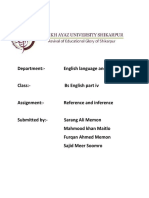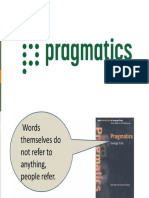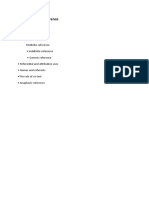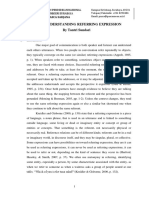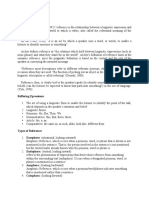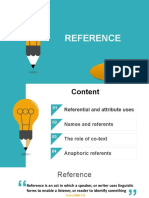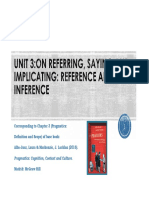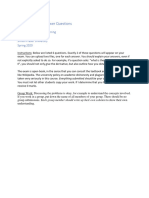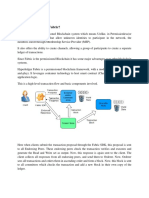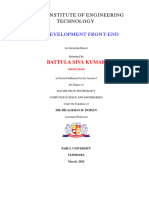Table of Contents
Table of Contents..............................................................................................................i
PREFACE.........................................................................................................................1
CHAPTER I.....................................................................................................................2
INTRODUCTION............................................................................................................2
A. Background of the Problem.....................................................................................2
B. Identification of the Problem...................................................................................3
C. Objective of the Study..............................................................................................3
CHAPTER II....................................................................................................................4
DISCUSSION...................................................................................................................4
A. Reference and Inference..........................................................................................4
B. Referential and Attributive Uses.............................................................................5
C. Names and Referents...............................................................................................7
D. The Role of Co-Text.................................................................................................8
E. Anaphoric Reference..............................................................................................10
CHAPTER III................................................................................................................12
CONCLUSION..............................................................................................................12
i
� PREFACE
The writer wants to thank to Almighty God because of His bless and
grace, he can finish this paper. This paper be entitled ”REFERENCE AND
INFERENCE”. The writer wrote it to fulfill the midterm assignment of Semantic
and Pragmatic
The author certainly realizes that this paper is far from perfect and there
are still many errors and shortcomings in it. For this reason, the author expects
criticism and suggestions from readers for this paper, so that this paper can later
become a better paper. Thus, and if there are many mistakes in this paper the
author apologizes profusely. I hope this paper can be useful. thanks.
Tangerang, April 2019
Compiler
1
� CHAPTER I
INTRODUCTION
A. Background of the Problem
Communication is essential for everyone to express feelings, exchange
information, delivering massages and many other functions of it. During the act of
communication human use language, containing sentences, words and smaller
units which also contribute to construct meaning. One distinctive character of
human language is the act of describing about something outside which been
known as ‘aboutness’ phenomenon (Hocket & Attman, 1968). Human don’t
only talk about something visible around them, but also abstract concept. Since
the things which human talk about is outside, they need to describe them using
words, phrases or sentences. Thus, the concept of ‘reference and inference’ is
proclaimed and become interesting issue to be explored by linguists.
Speaker and listener are cooperating to reach same understanding during
their act of communication, decoding expressions, word choices and links
(between one word to others) which been utilized to describe something. And the
cooperative understanding will only happen when they both successfully gain
mutual interpretation of what is expressed. Word itself doesn’t originally refer to
something, but human do. One utilized word will not always represent a
denotative meaning of it since humans’ opinion takes significant role of what
actually being referred, a meaning behind the meaning.
2
� In this paper, we will try to briefly expose the concept of reference
and inference in English pragmatics by reviewing some literatures, exploring
and discussing about its features and mentioning adequate examples to support
better understanding for everyone who learn.
B. Identification of the Problem
1. Reference and inference?
2. What is Referential and attributive uses?
3. What is the role of co-text?
4. What is Anaphoric reference?
C. Objective of the Study
1. Understand meaning of Reference and inference
2. Understand meaning of Referential and attributive uses
3. To know the role of co-text
4. To understand meaning of Anaphoric reference
3
� CHAPTER II
DISCUSSION
A. Reference and Inference
We might best think of reference as an act in which a speaker, or writer,
uses linguistic forms to enable a listener, or reader, to identify something. hose
linguistic forms are referring expressions, which can be proper nouns (for
example, 'Shakespeare', 'Cathy Revuelto', 'Hawaii'), noun phrases which are
definite (for example, 'the author', 'the singer', 'the island'), or indefinite (for
example, 'a man', 'a woman', 'a beautiful place'), and pronouns (for example, 'he',
'her', 'it', 'them'). The choice of one type of referring expression rather than another
seems to be based, to a large extent, on what the speaker assumes the listener
already knows. In shared visual contexts, those pronouns that function as deictic
expressions (for example, 'Take this'; 'Look at him!') may be sufficient for
successful reference, but where identification seems more difficult, more elaborate
noun phrases may be used (for example, 'Remember the old foreign guy with the
funny hat?').
Reference, then, is clearly tied to the speaker's goals (for example, to
identify something) and the speaker's beliefs (i.e. can the listener be expected to
know that particular something?) in the use of language. For successful reference
to occur, we must also recognize the role of inference. Because there is no direct
relationship between entities and words, the listener's task is to infer correctly
which entity the speaker intends to identify by using a particular referring
expression. It is not unusual for people to want to refer to some entity or person
4
�without knowing exactly which 'name' would be the best word to use. We can
even use vague expressions (for example, 'the blue thing', 'that icky stuff, 'ol'
what's his name', 'the thingamajig'), relying on the listener's ability to infer what
referent we have in mind. Speakers even invent names. There was one man who
delivered packages to our office whose 'real' name I didn't know, but whose
identity I could infer when the secretary referred to him as in [i].
[i] Mister Aftershave is late today.
The example in [i] may serve to illustrate that reference is not based on an
objectively correct (versus incorrect) naming, but on some locally successful
(versus unsuccessful) choice of expression. We might also note from example [i]
that successful reference is necessarily collaborative, with both the speaker and
the listener having a role in thinking about what the other has in mind
B. Referential and Attributive Uses
It is important to recognize that not all referring expressions have
identifiable physical referents. Indefinite noun phrases can be used to identify a
physically present entity as in [2a.], but they can also be used to describe entities
that are assumed to exist, but are unknown, as in [2b.], or entities that, as far as we
know, don't exist [2.C.].
[2] a. There's a man waiting for you.
b. He wants to marry a woman with lots of money.
c. We'd love to find a nine-foot-tall basketball player.
5
� The expression in [2b.], 'a woman with lots of money', can designate an
entity that is known to the speaker only in terms of its descriptive properties. The
word 'a' could be replaced by 'any' in this case. This is sometimes called an
attributive use, meaning 'whoever/whatever fits the description'. It would be
distinct from a referential use whereby I actually have a person in mind and,
instead of using her name or some other description, I choose the expression in
[2b.], perhaps because I think you'd be more interested in hearing that this woman
has lots of money than that she has a name
A similar distinction can be found with definite noun phrases. During a
news report on a mysterious death, the reporter may say [3] without knowing for
sure if there is a person who could be the referent of the definite expression 'the
killer'. This would be an attributive use (i.e. 'whoever did the killing'), based on
the speaker's assumption that a referent must exist. [
3 ] There was no sign of the killer.
However, if a particular individual had been identified as having done the
killing and had been chased into a building, but escaped, then uttering the
sentence in [3] about that individual would be a referential use, based on the
speaker's knowledge that a referent does exist. The point of this distinction is that
expressions themselves cannot be treated as having reference (as is often assumed
in semantic treatments), but are, or are not, 'invested' with referential function in a
context by a speaker or writer. Speakers often invite us to assume, via attributive
uses, that we can identify what they're talking about, even when the entity or
6
�individual described may not exist, as in [2c.]. Some other famous members of
that group are the tooth fairy and Santa Claus.
C. Names and Referents
The version of reference being presented here is one in which there is a
basic 'intention-to-identify' and a 'recognition-of-intention' collaboration at work.
This process need not only work between one speaker and one listener; it appears
to work, in terms of convention, between all members of a community who share
a common language and culture. That is, there is a convention that certain
referring expressions will be used to identify certain entities on a regular basis. It
is our daily experience of the successful operation of this convention that may
cause us to assume that referring expressions can only designate very specific
entities. This assumption may lead us to think that a name or proper noun like
'Shakespeare' can only be used to identify one specific person, and an expression
containing a common noun, such as 'the cheese sandwich', can only be used to
identify a specific thing. This belief is mistaken. A truly pragmatic view of
reference allows us to see how a person can be identified via the expression, 'the
cheese sandwich', and a thing can be identified via the name, 'Shakespeare'
For example, it would not be strange for one student to ask another the
question in [4a.] and receive the reply in [4b.].
[4] a. Can I borrow your Shakespeare? b. Yeah, it's over there on the table.
Given the context just created, the intended referent and the inferred
referent would not be a person, but probably a book (notice the pronoun 'it').
7
� There appears to be a pragmatic connection between proper names and
objects that will be conventionally associated, within a socioculturally defined
community, with those names. Using a proper name referentially to identify any
such object invites the listener to make the expected inference (for example, from
name of writer to book by writer) and thereby show himself or herself to be a
member of the same community as the speaker. In such cases, it is rather obvious
that more is being communicated than is said.
The nature of reference interpretation just described is also what allows
readers to make sense of newspaper headlines using names of countries, as
exemplified in [8a.] where the referent is to be understood as a soccer team, not as
a government, and in [8b.] where it is to be understood as a government, not as a
soccer team.
[8] a. Brazil wins World Cup.
b. Japan wins first round of trade talks.
D. The Role of Co-Text
The co-text clearly limits the range of possible interpretations we might
have for a word like 'Brazil'. It is consequently misleading to think of reference
being understood solely in terms of our ability to identify referents via the
referring expression. The referring expression actually provides a range of
reference, that is, a number of possible referents. Returning to a previous example,
we can show that, while the phrase 'the cheese sandwich' stays the same, the
8
�different co-texts in [9a.] and [9b.] lead to a different type of interpretation in each
ct;se (i.e. 'food' in [9a.] and 'person' in [9b.]).
[9J a. The cheese sandwich is made with white bread,
b. The cheese sandwich left without paying.
Of course, co-text is just a linguistic part of the environment in which a
referring expression is used. The physical environment, or context, is perhaps
more easily recognized as having a powerful impact on how referring expressions
are to be interpreted. The physical context of a restaurant, and perhaps even the
speech conventions of those who work there, may be crucial to the interpretation
of [9b.]. Similarly, it is useful to know that a hospital is the context for [ioa.], a
dentist's office for [iob.], and a hotel reception for [IOC.].
[10] a. The heart-attack mustn't be moved.
b. Your ten-thirty just cancelled.
c. A couple of rooms have complained about the heat.
The examples in [10] provide some support for an analysis of reference
that depends on local context and the local knowledge of the participants. It may
crucially depend on familiarity with the local socio-cultural conventions as the
basis for inference (for example, if a person is in a hospital with an illness, then he
or she can be identified by nurses via the name of the illness). These conventions
may differ substantially from one social group to another and may be marked
differently from one language to another. Reference, then, is not simply a
relationship between the meaning of a word or phrase and an object or person in
9
�the world. It is a social act, in which the speaker assumes that the word or phrase
chosen to identify an object or person will be interpreted as the speaker intended.
E. Anaphoric Reference
In English, initial reference, or introductory mention, is often indefinite ('a
man', 'a woman', 'a cat'). In [n] the definite noun phrases ('the man', 'the cat', 'the
woman') and the pronouns ('it', 'he', 'her', 'they') are examples of subsequent
reference to already introduced referents, generally known as anaphoric reference,
or anaphora. In technical terms, the second or subsequent expression is the
anaphor and the initial expression is the antecedent.
It is tempting to think of anaphoric reference as a process of continuing to
identify exactly the same entity as denoted by the antecedent. In many cases, that
assumption makes little difference to the interpretation, but in those cases where
some change or effect is described, the anaphoric reference must be interpreted
differently. In example [12], from a recipe, the initial referring expression 'six
potatoes' identifies something different from the anaphoric pronoun 'them' which
must be interpreted as 'the six peeled and sliced potatoes'
[12] Peel and slice six potatoes. Put them in cold salted water. There is
also a reversal of the antecedent-anaphor pattern sometimes found at the
beginning of stories, as in example [13].
[13] I turned the corner and almost stepped on it. There was a large snake
in the middle of the path.
10
� There is a range of expressions which are used for anaphoric reference in
English. The most typical forms are pronouns, such as 'it' in [14a.], but definite
noun phrases are also used, for example, 'the slices' in [14b.].
[14] a. Peel an onion and slice it.
b. Drop the slices into hot oil.
c. Cook for three minutes.
Note that the pronoun 'it' is used first and is difficult to interpret until the
full noun phrase is presented in the next line. This pattern is technically known as
cataphora, and is much less common than anaphora.
When the interpretation requires us to identify an entity, as in 'Cook (?) for
three minutes', in [14c], and no linguistic expression is present, it is called zero
anaphora, or ellipsis. The use of zero anaphora as a means of maintaining
reference clearly creates an expectation that the listener will be able to infer who
or what the speaker intends to identify. It is also another obvious case of more
being communicated than is said.
11
� CHAPTER III
CONCLUSION
Reference, then, is clearly tied to the speaker's goals (for example, to
identify something) and the speaker's beliefs (i.e. can the listener be expected to
know that particular something?) in the use of language. For successful reference
to occur, we must also recognize the role of inference. Because there is no direct
relationship between entities and words, the listener's task is to infer correctly
which entity the speaker intends to identify by using a particular referring
expression
12
